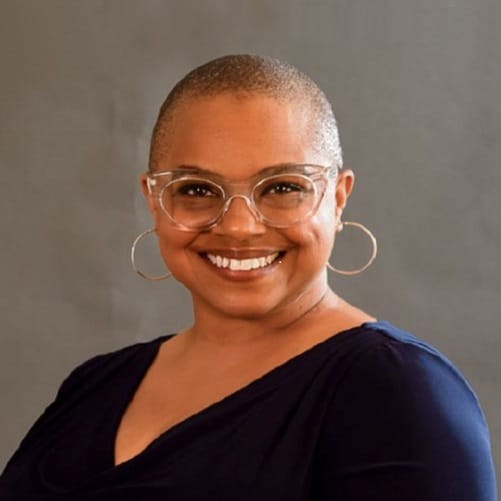
Jackye Clayton
Jackye Clayton cringes at the assertion that some people say they “don’t see color” when it comes to race.
It’s not just a naïve way of tackling the many-layered problem of racial disparities—it can actually be an active way of avoiding it.
“For many people, pretending not to see or feel things is their way of protecting themselves,” she said during an opening day keynote of Spring HR Tech (the free, virtual event runs through Friday; click HERE to register). It’s a radical but dangerous form of self-care, she said—similar to arguments that gun violence isn’t an epidemic, that climate change isn’t real and that economic inequality is blown out of proportion.
But when it comes to how these issues play out in the real world—including in the workplace—being blind to the issues isn’t an option any longer, she said.
“If you can pretend Black lives don’t matter and that you don’t see color, that means you can also pretend systemic racism doesn’t exist—but it does,” she said.
That way of thinking, Clayton noted, has led HR to go about building diverse workforces in all the wrong ways.
See also: 4 things to avoid if you want to diversify your talent pool
When recruiting diverse talent, she said, HR and recruiters often search for those who “fit the culture.” That’s antithetical to fostering diversity—and HR leaders have to “stop kidding themselves” so they can recognize that.
“If we’re truly committed to recruiting diverse candidates, we need to keep people whole and stop breaking them so they can become one of us,” she said. “When they can keep themselves whole, that’s when the magic happens.”
Related: Read more Spring HR Tech coverage here.
To get to that point, however, employers need to abandon habits and processes that were likely decades in the making. Here are six common mistakes Clayton said organizations need to avoid if they want to build truly diverse and inclusive organizations:
- Only looking for Black talent at HBCUs: Of the top 10 colleges and universities for Black student enrollment, only three are historically Black colleges and universities—so if an employer’s diversity recruiting strategy centers only on HBCUs, it’s leaving out more than 50,000 potential candidates. Ultimately, only 20% of Black students in the country who complete a bachelor’s degree do so at an HBCU. “So, how are you recruiting the other 80%?” Clayton asked.
- Emphasizing progressive experience: Job criteria that include phrases like “10 years of continuous leadership experience” are tone-deaf to the realities many marginalized employees face. For example, 90% of transgender individuals report having experienced harassment or mistreatment at work; how long should they stay at that job—and what opportunities for advancement might they really have if they’re in a discriminatory environment—in order to secure a resume showcasing progressive experience?
- Not targeting potential employees with disabilities: Clayton noted that 11% of post-secondary undergrads report having some sort of disability—but disability is often not counted among employers’ diversity goals. “Don’t overlook the often-overlooked,” she said.
- Starting diversity efforts with entry-level roles: On a recent webinar that was comprised of 90% cisgender males, Clayton said, one individual suggested the best way to increase diversity was to hire young women straight out of college to join the sales team—she joked that she wanted to call 911. That same person suggested diversity and bias training isn’t crucial. “You have to make sure you have diverse leaders in order to hold subordinates accountable to diversity goals and to create a safe environment,” she said.
- Expecting technology to solve a problem that a lack of technology didn’t create: While technology can be a vital tool to help attract and retain diverse talent, organizations can’t leverage tech’s true potential without getting to the heart of their own diversity problem first. “The problem in the organization in regard to bias didn’t start when you started buying tech—it started when you started hiring people who were unaware of their own biases,” she said.
- Retaining problem employees: Clayton doesn’t advocate for firing employees who don’t know how to hire diverse talent; rather, organizations need to part ways with those who are “so afraid of losing their power and comfort that they would rather do what they’ve always done to keep what they think only belongs to them.” The driving reason for a lack of diverse talent isn’t an actual lack of diverse talent—it’s that there are “too many racist, misogynistic, bigoted, sexist, homophobic, unaware people in leadership today,” she asserted. Organizations that recognize that they need to change their culture to welcome diversity—instead of trying to make diverse populations fit into their current culture—will be best-prepared to build a foundation of diversity.
Click HERE to listen to Jackye Clayton’s full keynote address.